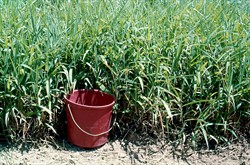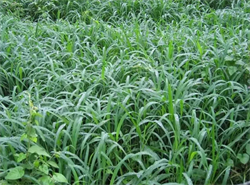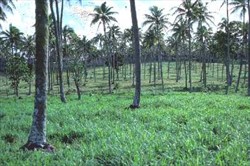Panicum trichocladum
Tropical Forages
Panicum trichocladum Hack. ex K. Schum.
None listed in GRIN.
Family: Poaceae (alt. Gramineae) subfamily: Panicoideae tribe: Paniceae subtribe: Panicinae.
Shortly rhizomatous, fine stemmed perennial, 0.2‒1 m tall (rarely to 1.5 m) with scrambling, decumbent, much branched culms 0.2–3 m long, developing nodal roots when touching or close to the ground. Leaf blades almost horizontally spreading, light green to green, narrowly lanceolate to lanceolate, 5–20 (–30) cm long, (4–) 10–15 (–18) mm wide; rounded at the base, apex acuminate; ligule a ciliate membrane 2 mm long; leaf-blade surface pilose, margins scabrous. Panicle open, ovate, 6–20 cm long, moderately branched, usually sparsely long-ciliate on the distal branches and pedicels and densely hairy on the main axis around and immediately below the lowest branches, rarely glabrous; panicle branches pilose, rarely glabrous; spikelets (2.2–) 2.5–3 mm long.
Africa: ikoka, mkoko, nyasi, ukoka (Tanzania)
English: creeping guinea grass (Australia); donkey grass
Latin America: capim aruana (Brazil)
Native:
Africa: Democratic Republic of the Congo; Ethiopia (s.); Kenya; Malawi; Mozambique; Sudan (s.); Tanzania; Uganda; Zambia; Zimbabwe
Forage
Used for permanent pasture if fertility maintained. Provides good shade-tolerant ground cover, making it useful for agroforestry including pasture under coconuts.
Environment
Also useful for soil conservation and bench development in terraced contour cultivation systems.
Soil requirements
Often found on sandy or gravely soils, but also on loams and clay loams. Adapted to most well-drained, friable, fertile soils.
Moisture
Occurs mostly in areas receiving >850 mm/yr, sometimes with a pronounced dry season of up to 7 months. Adapted to areas receiving >2,000 mm/yr.
Temperature
Occurs from sea level to 2,300 m. Good cool season growth in some genotypes.
Light
Occurs in light forests and forest edges, in bush and along stream banks. Some varieties recognized for ability to grow in shaded conditions, e.g. ‘Embu’.
Reproductive development
Single record of flowering November to January in upland Uganda.
Defoliation
While tolerant of heavy grazing, it is less so than many other stoloniferous grasses such as Digitaria eriantha (Pangola grass).
Fire
No data, but probably similar to M. maximus and not adversely affected by fire in the long term.
Guidelines for establishment and management of sown forages.
Establishment
Germination should be tested, since seed may not reach maximum germination until up to 18 months after harvest. Dormancy can be overcome by removal of glumes from fresh seed. Seed can be drilled or broadcast at 2–3 kg/ha. Being a small seed, it should be planted at no more than 1 cm deep. Rolling after sowing improves germination and establishment. This group can also be established from slips, stolon plantlets, or pieces of stolon with several nodes, planted on the contour every 0.5–0.6 m in rows 1.25–1.5 m apart.
Fertilizer
Establishment fertilizer is necessary on infertile soils, using 20–40 kg/ha P, and about 50 kg/ha N if limited cultivation prior to planting. Maintenance fertilizer is needed for pure grass swards especially in cut-and-carry systems. Inadequate N will lead to weakening of the stand and invasion by less desirable species. Maintenance dressings of 200–400 kg/ha/yr of N are required to promote healthy, productive stands on less fertile soils. Soils with pH <5 require addition of lime to bring pH up to 5.5–6.
Compatibility (with other species)
Combines well with twining legumes under light grazing, and more stoloniferous legumes under intensive management. Can be grown successfully under open forest or plantation due to shade tolerance.
Companion species
Grasses: Chloris gayana.
Legumes: Centrosema molle, Macroptilium atropurpureum, Macrotyloma axillare, Neonotonia wighti, Neustanthus phaseoloides, Stylosanthes guianensis var. guianensis, S. capitata, S. macrocephala, Leucaena leucocephala, Vigna hosei.
Pests and diseases
Ergot (Claviceps spp.), and other fungal diseases, Conidiospormyces ayresii, Fusarium roseum, and Tilletia sp. can reduce seed yields when conditions are favourable to the pathogen. Seed production has also been adversely affected by a smut (Ustilago sp.) in Colombia and bunt in the Rift Valley of Kenya. In Puerto Rico a leaf spot caused by Cercospora fusimaculosus has been recorded.
‘Aruana’ is moderately tolerant of spittlebug variously known as cigarrinha (Brazil), chicharrita (Argentina), salivazo and mión (Colombia) (Notozulia entreriana, Deois flavopicta, D. incompleta, Mahanarva spp., Aeneolamia reducta, A. selecta (Homoptera, Cercopidae) in tropical America. A "small-leaf virus", possibly a phytoplasma, has been recorded on 'Aruana'. Streak virus disease has killed populations of 'Embu'.
Ability to spread
Spreads by virtue of stoloniferous growth habit and significant seed set.
Weed potential
Troublesome weed in sisal and coffee plantations; common in wastelands. Causing some concern by virtue of spread in Sri Lanka.
Nutritive value
Young active growth has been measured to have 17.5% CP and 0.29% P, declining with age to 8.5% CP and 0.1% P in mature growth during the dry season. 'Aruana' is characterised as having 7.5–12% CP, 64% IVDMD.
Palatability/acceptability
Palatable to cattle and sheep. The young leaves regarded as especially suitable for calves, and it is still grown to a limited extent as a calf feed.
Toxicity
None reported.
Feedipedia link
April 2020: Page under construction
Dry matter
Commonly 10–20 t/ha DM, depending on variety and growing conditions, particularly levels of N applied.
Animal production
Can achieve up to 0.8 kg/hd/day LWG and up to 1,200 kg/ha/yr LWG (commonly 300–500 kg/ha/yr LWG) depending primarily on stocking rate and N fertilizer rate.
2n = 32. Facultative apomicts in which both apospory and pseudogamy occur.
P. trichocladum is one of three species in the agamic complex of the Maximae (Panicoideae), the others being Megathyrsus maximus and M. infestus. P. trichocladum was specifically not reassigned to Megathyrsus because its leaf anatomy and photosynthesis subtype are different from those found in the other two species. However, intermediate types between M. maximus and P. trichocladum have been identified.
Best in environments with longer day lengths and distinct dry seasons. Seed ripens unevenly, and is shed as it matures. Highest seed yield (19% recovery) obtained when the panicle has shed 40–60% of its spikelets, which occurs about 12–14 days from panicle emergence. Direct heading is less efficient in terms of seed recovery than mowing, windrowing and sweating. Yields of 50–100 kg pure seed yield are common from machine harvest, and around 200 kg/ha from ground sweeping, although higher yields have been recorded.
No data for this group, but probably similar to M. maximus:
“Atrazine can be used for weed control in M. maximus at 4 L/ha. 'Gatton' can tolerate over 4.5 kg/ha a.i. whereas common weeds such as Nicandra physaloides, Raphanus raphanistrum, Argemone ochraleuca, Ageratum conyzoides, Sida cordifolia and Eleusine indica are killed at 0.9 kg/ha a.i..
M. maximus can be prevented using a pre-emergent spray (no wetting agent required) of 2,4-D sodium salt at 4.5 kg/ha of an 840 g/kg a.i. product using a minimum of 340 L/ha of water. It is susceptible to glyphosate and readily controlled by drizzle applications. Young plants are susceptible to selective grass-killers, and diuron at 2.5 kg/ha of an 800 g/kg a.i. in a minimum of 340 L of water per hectare. Mature plants can also be killed using 2,2-DPA at 2.3 kg of a 740 g/kg a.i. product plus paraquat at 85 ml of a 200 g/L a.i. product plus wetting agent at 250 mL per 200 L of water, spraying to point of runoff.”
- Very leafy.
- Readily eaten by all stock.
- Suited to grazing and cutting.
- Moderately tolerant of heavy grazing.
- Moderately drought tolerant.
- Early season growth in some lines.
- Requires fertile soils.
- Intolerant of waterlogging.
Bogdan, A.V. (1977) Tropical Pasture and Fodder Plants. Longman Inc., New York, USA. p. 181–192.
Clayton, W.D. and Renvoize, S.A. (1982) Gramineae (Part 3). In: Polhill, R.M. (ed) Flora of tropical East Africa. Royal Botanic Gardens, Kew, UK.
Grof, B. and Harding, W.A.T. (1970) Dry matter yields and animal production of guinea grass (Panicum maximum) on the humid tropical coast of North Queensland. Tropical Grasslands 4:85–95. bit.ly/2ylKtFH
Harty, R.L., Hopkinson, J.M., English, B.H. and Alder, J. (1983) Germination, dormancy and longevity in stored seeds of Panicum maximum. Seed Science & Technology 11:341–351.
McCosker, T.H. and Teitzel, J.K. (1976) A review of guinea grass (Panicum maximum) for the wet tropics of Australia. Tropical Grasslands 9:177–190. bit.ly/2WX5TDg
Middleton, C.H. and McCosker, T.H. (1975) Makueni, a new guinea grass for North Queensland. Queensland Agricultural Journal 101:351–355.
Pernès, J. (1975) Organisation evolutive d’un groupe agamique: la section des Maximae du genre Panicum (Graminées). ORSTOM, Paris, France.
Savidan, Y.H., Jank, L. and Costa, J.C.G. (1990) Registro de 25 acessos selecionados de Panicum maximum. Embrapa Gado de Corte, Campo Grande, Brazil. bit.ly/3bDPMi1
‘Aruana’ (IZ 5) Released in Brazil (1989). Fine-stemmed, stoloniferous, usually <1 m tall; narrow leaves, long growing season, very good seed production, very aggressive, very palatable, high quality feed, suited to heavy grazing by all livestock, including sheep and goats. Adapted to areas with >1,000 mm rainfall. Yields of about 20 t/ha/yr DM with 30–40% in dry season (April–September). Drought resistant and moderately tolerant of frost and spittlebug. Considered to be Megathyrsus maximus in Brazil.
‘Embu’ (Q 8132, K6237, ORSTOM G24, BRA 004367) Released in Kenya and tested in Australia. Origin Embu, Kenya (0.50° S, 37.40° E, 1,500 m asl, rainfall 1,100 mm). Grows to 1–1.5 m tall. Leaf-blades 20–30 cm long and 12–17 mm wide; occasional short hairs on the leaf surface, and sparse short hairs on the lower outside of the sheath near the node junction; occasional hairs on the lower stem internodes. Panicle 15–20 cm long, 12–15 cm wide, green. A leafy, palatable variety, but intolerant of heavy grazing. Good winter growth, but low seed production. Good shade tolerance. Well adapted to very high rainfall environments (2,500–3,500 mm/yr).
None reported.







